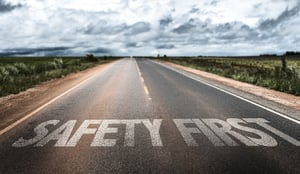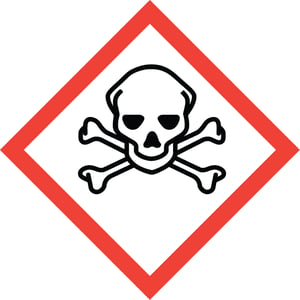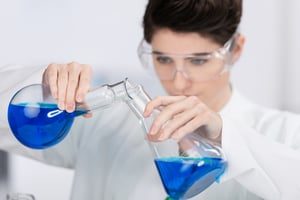Researchers, scientists and students all share a common love for exploring the unknown and pushing the boundaries of human knowledge. Yet as exciting as laboratory work can be, it’s crucial to never forget the importance of safety.
From corrosive chemicals to high-voltage electrical equipment, the lab can be a hazardous place if proper precautions aren’t taken. Whether a seasoned veteran or a newcomer to the lab, here are 10 important rules to follow to stay safe and thriving in this exciting environment:
-
Know your lab.
-
Review lab safety symbols.
-
Wear the proper protection.
-
Choose the right lab safety goggles.
-
Perform safety checks on the fume hood.
-
Ensure all substances are properly stored.
-
Make sure labels include proper information.
-
Report and replace damaged electrical equipment.
-
Have a safety plan in place.
-
Become aware of sources that help promote safety.
Know Your Lab’s Safety Information
It may sound like a dose of common sense, but safety in the lab requires knowledge of your lab. At times, the most basic awareness of elements in your lab is overlooked. Safety begins with knowledge, so it’s important for everyone who works in your lab to be aware of:
the most basic awareness of elements in your lab is overlooked. Safety begins with knowledge, so it’s important for everyone who works in your lab to be aware of:
-
The substances and chemicals you work with, whether regularly or occasionally
-
Appropriate safety protocols for handling chemicals and other hazardous materials
-
Locations of laboratory safety equipment, including safety showers, eyewash stations, fire extinguishers and first aid kits
-
Emergency exit routes, which should be properly and clearly labeled on evacuation maps
-
The location of important lists, like chemical inventory lists, material safety data sheets (MSDS or SDS), department laboratory safety manuals and standard operating procedures (SOPs)
Overall, it’s important for lab personnel to have a strong understanding of the materials and processes they work with on a daily basis, as well as how to operate safely and respond appropriately in emergency situations.
Review Lab Safety Symbols
Reviewing safety symbols regularly allows lab personnel to refresh their knowledge and stay up-to-date on the latest safety rules and best practices. This helps them avoid complacency and maintain a vigilant mindset, which is critical when working with hazardous waste or materials.
the latest safety rules and best practices. This helps them avoid complacency and maintain a vigilant mindset, which is critical when working with hazardous waste or materials.
Safety symbols are designed to provide quick and clear information about the potential dangers of a particular substance or process, helping to prevent accidents and injuries.
The Occupational Safety and Health Administration (OSHA) has adopted the Globally Harmonized System of Classification and Labeling of Chemicals (GHS) in the United States. The GHS is part of OSHA’s Hazard Communication Standard (HCS) and includes nine important lab safety symbols anyone working in this type of environment should know.
Each of the pictograms illustrates a type of hazard often found in labs. Their simple designs are planned so that anyone in a laboratory can recognize what they mean quickly. You can review these symbols in our article, Know Your Lab Safety Symbols.
Keep in mind that in addition to these standard safety symbols, individual labs may use other symbols to identify safety protocols. For example, evacuation maps or safety checklists may look different in each laboratory. Periodic reviews can help laboratory workers keep up to date on any important safety protocols in your particular lab.
Wear The Proper Protection
Lab employees are at a higher risk of exposure to potential dangers like chemical spills, fires and physical injuries. To mitigate these risks, lab garments and protection are an essential part of any laboratory environment.
Personal protective equipment (PPE) in your lab may include:
-
Clean room garments like lab coats, coveralls and full body suits
-
Eye protection like goggles and face shields
-
Gloves
-
Protective hearing devices
-
Hard hats
-
Respirators
-
Safety shoes and protectors
-
Surgical face masks
The PPE you have on-hand also may depend on the dangers your lab poses. For example, if spark sources are a major concern, fabric that protects against ESD should be considered.
Another concern is the impact of chemicals on fabric. For example, polypropylene allows moisture to evaporate more quickly than traditional clothing. It is also resistant to many acids and alkalis that may be used in a laboratory setting.
If working with flammable liquids, it’s best to avoid fabric made with synthetic fibers since synthetic fibers tend to melt and stick to exposed skin when exposed to flames.
Choose The Right Lab Safety Goggles
Safety goggles are a common piece of lab safety equipment found in different types of laboratories, including biology, chemistry, physics, product testing, pharmaceutical and more. There are several common types of eye hazards in a laboratory space, including:
including biology, chemistry, physics, product testing, pharmaceutical and more. There are several common types of eye hazards in a laboratory space, including:
-
Chemicals
-
Gases
-
Fumes
-
Vapors
-
High-energy light
-
Machinery
-
Particles
-
Laser light
-
Ultraviolet light
-
Bloodborne pathogens
-
Biological agents
-
Broken glass
-
Heating sources
-
Other projectiles
Knowing the right lab safety goggles to protect against these hazards is critical.
Non-vented goggles protect a worker’s eyes from vapors, mists and fumes, as well as any other hazards that would require eyes to be completely shielded such as chemicals or bloodborne pathogens.
Vented goggles provide a moderate amount of protection from liquids as long as they do not emit vapors or mist. Some laboratory goggles allow air to pass through but include a physical barrier to liquids. Other vented goggles, like those found at a hardware store that have holes in the plastic, would not be suitable for some lab environments.
In addition to goggles, there are other types of safety eyewear that could offer protection in labs.
Lab safety glasses often have shatter-resistant lenses and are designed to stop large objects from injuring eyes. They also may be designed to provide laser light filtration or to prevent laser reflections from entering the eye. While safety glasses do not offer as much protection from liquids and vapors as safety goggles, they can offer protection in the appropriate work environment.
Another option are face shields. While face shields are not designed to be the only eye protection a lab worker should wear, they can help provide additional protection when worn over safety goggles. Face shields also help protect the entire face, rather than only eyes.
Perform Safety Checks On The Fume Hood
A laboratory fume hood is a common piece of equipment found in laboratories. While they play an important role in lab operations, if not properly maintained, they can create significant safety hazards.
A fume hood should undergo a safety check before every use. Developing a fume hood safety checklist can help ensure this occurs. Your checklist should include the following directions:
-
Ensure the hood sash is opened to the proper height to provide the proper level of protection.
-
Check the air gauge to ensure the airflow is within the required range.
-
Make sure the exhaust fan is working so that hazardous chemical fumes can escape.
-
Check the baffles in the exhaust fan since these keep airflow uniform.
-
Double check there are no spark sources nearby that can cause a fire or explosion.
-
Examine the air filters to ensure they are not clogged.
Double checking that the fume hood is free from any obstructions is another routine safety check that staff should perform. Obstructions include chemicals, equipment and other items that could interfere with proper airflow or pose a safety hazard.
Ensure All Substances Are Properly Stored
Proper storage of chemicals in science labs is critical to ensure the safety of workers, the environment and the integrity of scientific experiments. Improper storage can lead to accidents, fires, explosions or other dangerous situations that can harm people, damage equipment and cause environmental contamination.
The loss of valuable chemicals also can be costly and time-consuming to replace, and may compromise the accuracy of research results. For these reasons, following guidelines for safe and proper storage is crucial.
There are several key guidelines that workers should follow when storing chemicals in labs:
-
Chemicals should be clearly labeled and stored in appropriate containers, such as glass or plastic bottles with tightly fitting caps.
-
These containers should be stored in designated areas that are well-ventilated and free from direct sunlight, heat, and moisture.
-
Incompatible chemicals should be kept separate to avoid the risk of chemical reactions that could cause dangerous or explosive situations.
-
Workers should be trained in the safe handling and storage of chemicals.
-
Workers should also be aware of emergency procedures in case of spills, fires or other accidents.
-
Regular inspections of chemical storage areas should be conducted to ensure that containers are properly labeled, sealed and in good condition, and that there are no signs of leakage or damage.
Following guidelines for safe storage can help prevent accidents and ensure the integrity of research results.
Make Sure Labels Include Proper Information
All chemicals and substances in the lab, especially if they are considered hazardous materials, should be properly labeled.
Chemical labels should include the following information:
-
Product name and manufacturer information: The name of the chemical and the name and contact information of the manufacturer.
-
Hazard warnings: The label should include a list of potential hazards associated with the chemical, including any physical, health and environmental hazards.
-
Precautionary statements: The label should provide instructions on how to handle the chemical safely, including precautions to take when handling the substance, first-aid measures and what to do in case of accidental exposure.
-
Chemical ingredients: All of the chemical ingredients in the product, including their common names and the percentage of the ingredient in the product, should be included.
-
Physical properties: Physical properties of the chemical may include its appearance, odor, boiling point, flash point and vapor pressure.
-
Storage and handling information: The label should provide information on how to properly store and handle the chemical, including any special storage requirements and recommended handling procedures.
-
Disposal instructions: Instructions should include how to safely dispose of the chemical, including any local or federal regulations that need to be followed.
-
Emergency contact information: The label should include emergency contact information, such as a phone number for the manufacturer or the local poison control center.
It’s also important to regularly check labels to make sure any ink has not worn off or part of a label is missing. If this occurs, promptly replace the label so that all of the above information is visible.
Report And Replace Damaged Electrical Equipment
Report damaged electrical equipment and other types of lab equipment to a supervisor right away. Damaged equipment can pose a serious risk to the health and safety of those working in the lab by causing electric shocks, short circuits, fires or even explosions.
Damaged glassware and other lab equipment can also pose hazards after breaking or shattering, potentially causing cuts or other injuries.
Once notified, the supervisor can take immediate action to address the issue. Depending on the severity of the damage, the supervisor may need to take a piece of equipment out of service or take other necessary steps to ensure that the lab is safe for everyone.
Have A Safety Plan In Place
Safety procedures are put into place to prevent accidents. However, in the event an accident occurs, it’s just as important to be prepared to minimize the potential for hazards and the risk to human health.
A comprehensive safety plan includes preparations to avoid emergencies and what should occur if any emergency happens. The following elements are ideas that can help make your lab’s safety plan comprehensive:
-
Hazard Assessment: The first step in developing a lab safety plan is to identify potential hazards in the lab. This should include a thorough evaluation of all chemicals, equipment and processes used in the lab to determine potential risks.
-
Standard Operating Procedures (SOPs): Once potential hazards have been identified, the lab safety plan should include detailed procedures for safely handling, storing and disposing of all chemicals and equipment used in the lab. These procedures should be specific to the lab’s operations and tailored to address the identified hazards.
-
Personal Protective Equipment (PPE): The lab safety plan should identify the necessary PPE for lab personnel, including gloves, goggles, respirators and lab coats. The plan should also include procedures for properly using, storing and maintaining PPE.
-
Emergency Procedures: The lab safety plan should include emergency procedures in the event of accidents or incidents such as chemical spills, fires or injuries. These procedures should include evacuation routes, emergency contact information and instructions for reporting incidents.
-
Training: All lab personnel should receive training on the lab safety plan and procedures, including hazard recognition, proper use of PPE and emergency procedures.
-
Inspections and Audits: The lab safety plan should include regular inspections and audits to ensure that all equipment is in good condition, all hazardous materials are properly stored, and all personnel are following the established safety procedures.
-
Record Keeping: A system for recording incidents, inspections and training helps to ensure that the lab is in compliance with regulations and that all personnel are following established safety procedures. These can be of particular importance should an emergency occur and principal investigators with to see your lab’s safety records.
By identifying potential hazards and establishing procedures for safely handling equipment and materials, lab personnel can minimize the risk of accidents and ensure a safe and effective work environment.
Be Aware Of Sources That Help Promote Safety
Laboratory safety involves identifying, assessing and controlling hazards associated with working in a lab environment. This requires not only adherence to safety guidelines and procedures, but also continuous education and training to stay up-to-date with the latest safety practices and equipment.
Fortunately, there are many sources available to help promote lab safety.
For example, the Occupational Safety and Health Administration (OSHA), the UC Center for Laboratory Safety and the ACS Center for Lab Safety are quality organizations that promote safety in the lab. Many of these organizations offer training, safety videos, safety tools and examples of standard operating procedures you can use to make your lab the safest possible for your employees.
Laboratory equipment manufacturers also play an important role in promoting lab safety. Many manufacturers provide user manuals, safety data sheets and training materials to help users understand the potential hazards associated with the equipment and how to safely operate it. Many manufacturers provide technical support to answer questions and address concerns related to equipment safety as well.
By being aware of these and other sources that help promote lab safety, lab personnel can stay informed on the latest procedures, updates and practices, which ultimately contributes to a safer, more productive lab environment.


